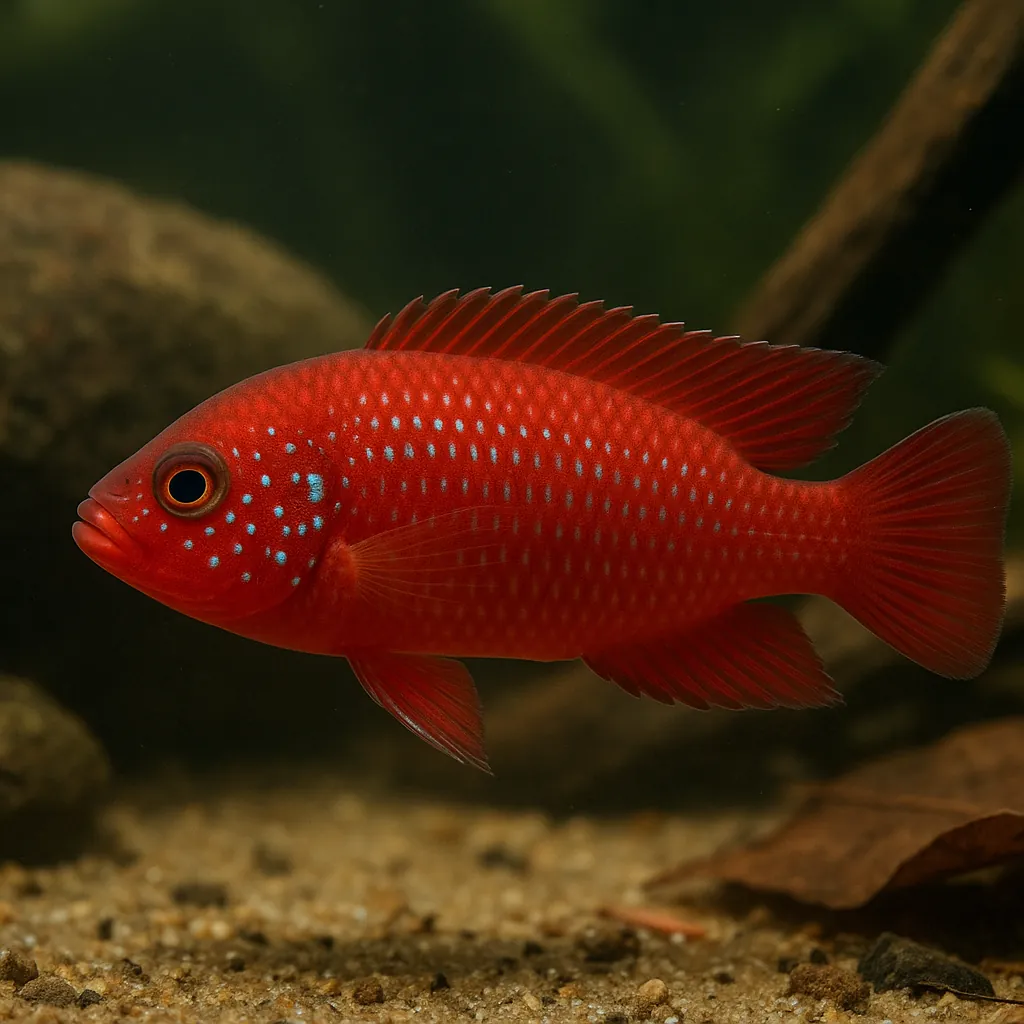
Lifalili cichlid
Introduction
The Lifalili cichlid, also known as the Blood-Red Jewel Cichlid (Hemichromis lifalili), is a striking freshwater fish renowned for its vibrant red coloration adorned with iridescent blue spots. This species is a favorite among aquarists due to its dazzling appearance and engaging behaviors. While they offer a captivating addition to home aquariums, Lifalili cichlids require attentive care and an understanding of their specific needs to thrive.
What makes the Lifalili cichlid a popular choice for aquarists?
Their vivid red hues and dynamic behaviors make them a visually appealing and interactive species, enhancing the aesthetic and activity levels of aquariums.
Are Lifalili cichlids suitable for beginner fishkeepers?
Due to their territorial nature and specific care requirements, they are better suited for aquarists with some experience in managing cichlid species.
Care and Environment
Proper care for Lifalili cichlids involves creating an environment that mirrors their natural habitat and meets their behavioral needs.
What is the minimum tank size for a pair of Lifalili cichlids?
A minimum tank size of 70 liters is recommended for a single pair to provide adequate space and reduce territorial disputes.
What are the ideal water parameters for Lifalili cichlids?
Maintain a temperature between 23-26°C, a pH of 6.0-7.8, and water hardness of 4-15°H to replicate their natural conditions.
Filtration should be robust to ensure high oxygen levels, as these cichlids thrive in well-oxygenated water. Moderate lighting is sufficient, and incorporating floating plants can help diffuse light and provide additional cover.
Diet should be varied, including high-quality cichlid flakes or pellets supplemented with live or frozen foods like bloodworms, brine shrimp, and daphnia. Including vegetable matter such as spirulina flakes or blanched spinach is beneficial.
Decorate the tank with rocks, driftwood, and sturdy plants to create hiding spots and territories. Be aware that Lifalili cichlids may dig, so secure plants properly. During breeding, they become highly territorial and aggressive, necessitating ample space and hiding places to manage aggression.
How can aggression be managed during the breeding season?
Providing a spacious tank with multiple hiding spots and visual barriers can help reduce aggression by allowing fish to establish and defend their territories.
Origin and Habitat
Native to the Democratic Republic of Congo, Lifalili cichlids inhabit still and slow-moving creeks and tributaries rich in oxygen. These environments often feature overhanging and surface vegetation, with muddy substrates. Water temperatures typically range from 22-24°C, with neutral to slightly acidic pH levels.
What type of water bodies do Lifalili cichlids naturally inhabit?
They are found in still and slow-moving creeks and tributaries that are rich in oxygen.
What are the typical water conditions in their natural habitat?
Water temperatures range from 22-24°C, with neutral to slightly acidic pH levels.
Temperament and Compatibility
Lifalili cichlids are territorial and can exhibit aggression, especially during breeding. They are best kept in pairs or with other robust, similarly sized fish that can tolerate their behavior. Suitable tank mates include larger tetras, catfish, and other semi-aggressive cichlids. Avoid housing them with small, peaceful species, as they may become targets of aggression.
Can Lifalili cichlids be kept with other fish?
Yes, but they should be housed with robust, similarly sized fish that can tolerate their territorial nature.
What are some suitable tank mates for Lifalili cichlids?
Larger tetras, catfish, and other semi-aggressive cichlids are appropriate companions.
To minimize aggression, provide a spacious tank with plenty of hiding spots and visual barriers, allowing each fish to establish its own territory.
Interesting Facts
Lifalili cichlids are known for their exceptional parental care. Both parents actively guard and tend to their eggs and fry, often moving them to different locations within the tank for protection. This behavior provides aquarists with a fascinating display of cichlid parenting.
How do Lifalili cichlids care for their offspring?
Both parents guard and tend to their eggs and fry, often relocating them within the tank for safety.
What distinguishes Lifalili cichlids from similar species?
They can be identified by the two dark spots on their flanks, whereas similar species like Hemichromis bimaculatus have three spots.
These cichlids are also known for their color changes during breeding, with their red hues intensifying, making them even more striking during this period.
Sources
All information in this article has been gathered from the following reputable sources:
Overview
Recommended Tank Size 52.8 Gallons (for groups or optimal conditions) |
Minimum Group Size 2 |
Minimum Tank Volume 18.5 Gallons |
Maximum Adult Length 3.9 inches |
Average Adult Length 3.1 inches |
Shoaling (6+ required) No |
Preferred Water Type Freshwater, neutral to slightly acidic |
Temperature Range (°C) 23-26 |
pH Range 6.0-7.8 |
Water Hardness (dGH) 4-15 |
Typical Lifespan (years) 5 years |